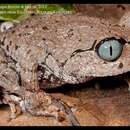Description
(
anglais
)
fourni par AmphibiaWeb articles
Leptobrachium bompu is a frog of moderate size, 47 mm (SVL) with a rounded body. Its distinguishing characteristic is the uniform grey-blue coloration of the iris, which is found only in one other Leptobrachium (L. waysepuntiense) in Sumatra, Indonesia. Its pupil is vertical and black. The head is wider than it is long. Snout and dermal projections are absent unlike some members of Leptobrachium. Tympanum is indistinct. Skin on dorsal and lateral parts of the head and body have fine ridges forming reticulum, lending it a wrinkly appearance. Ventral parts of head, body, and limbs are covered with small glandular warts. The tibia is longer than 40% of SVL. Finger tips and toe tips are swollen. Toes are short and thin. It has webbing leaving 3.5 phalanges of toe IV and 2 phalanges of toe V free. Its second finger is the shortest. Relative length of fingers: II less than I less than IV less than III. Relative length of toes: I less than II less than V less than III less than IV. It has vocal sacs that are not distinct externally, and nuptial spines are not present (Sondhi and Ohler 2011).Ventral surface of belly and legs is dark purple with small white spots. Dorsum and head are grayish-brown; upper side of forearms and legs is grey with darker cross bands. In alcohol, dorsal and lateral parts of head and body are brown with irregular distinct darker markings. Dorsal parts of limbs are brown with dark brown narrow bands, and the posterior part of the thigh is light brown with reduced white spotting. Throat and chest are light brown; belly is brown with white spots, and webbing is dark brown (Sondhi and Ohler 2011).Leptobrachium bompu is named after the camp site near where it was discovered, Bompu, in order to increase awareness in the community about conserving the forests. It is the third species of the genus Leptobrachium to be found in India. This species was described by Sanjay Sondhi and Annemarie Ohler in 2011.
Sondhi, Sanjay, and Ohler, Annemarie (2011). ''A Blue Eyed Leptobrachium (Anura: Megophryidae) from Arunachal Pradesh, India.'' Zootaxa, (2912), 29-36.
Distribution and Habitat
(
anglais
)
fourni par AmphibiaWeb articles
This species is found in Bompu in the Eaglenest Wildlife Sanctuary, West Kameng district, Arunachal Pradesh, India, at an altitude of 2000 m. The type specimens were found near a slow-flowing stream during heavy rain. This area is under forest cover, transitioning between East Himalayan subtropical wet hill forest at lower altitudes and East Himalayan wet temperate forest at higher altitudes (Sondhi and Ohler 2011).
Life History, Abundance, Activity, and Special Behaviors
(
anglais
)
fourni par AmphibiaWeb articles
This frog is terrestrial, found under leaf litter. It lives around perennial streams. Sondhi and Ohler (2011) report hearing their calls from up and downstream, during the day and night. The male's croak is loud and sounds like a 'kek-kek-kek'.
Leptobrachium bompu: Brief Summary
(
anglais
)
fourni par wikipedia EN
Leptobrachium bompu is an extant species of eastern spadefoot toads described in 2011. It is only known from its type locality in the Eaglenest Wildlife Sanctuary in Arunachal Pradesh, Northeast India. The specific name refers to the camp site, Bompu, in the vicinity of the type locality.
- licence
- cc-by-sa-3.0
- droit d’auteur
- Wikipedia authors and editors

